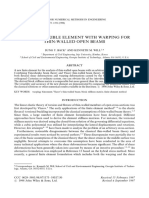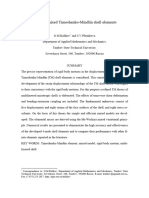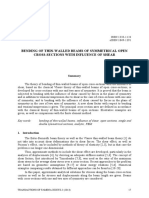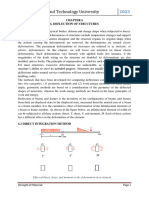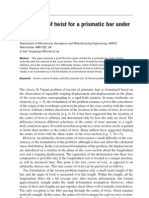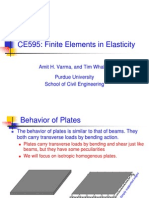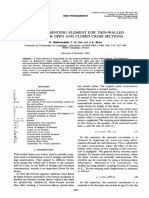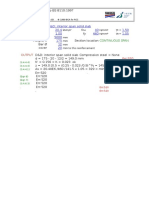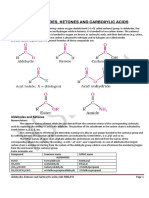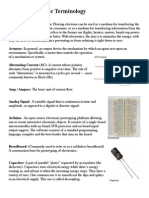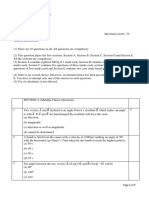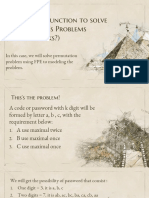Center of Gravity and Shear Center of Thin-Walled Open-Section Composite Beams
Center of Gravity and Shear Center of Thin-Walled Open-Section Composite Beams
Uploaded by
redz00Copyright:
Available Formats
Center of Gravity and Shear Center of Thin-Walled Open-Section Composite Beams
Center of Gravity and Shear Center of Thin-Walled Open-Section Composite Beams
Uploaded by
redz00Original Title
Copyright
Available Formats
Share this document
Did you find this document useful?
Is this content inappropriate?
Copyright:
Available Formats
Center of Gravity and Shear Center of Thin-Walled Open-Section Composite Beams
Center of Gravity and Shear Center of Thin-Walled Open-Section Composite Beams
Uploaded by
redz00Copyright:
Available Formats
Center of gravity and shear center of thin-walled open-section
composite beams
Jaehong Lee
Department of Architectural Engineering, Sejong University, 98 Kunja Dong, Kwangjin Ku, Seoul 143-747, South Korea
Abstract
The denition of center of gravity and shear center of a thin-walled open-section laminated composite beam is a function of the
geometry and the material properties of the section. The method is applicable to any arbitrary laminate stacking sequence, i.e.
unsymmetric as well as symmetric, and shape of the cross section. Numerical results are obtained for singly symmetric channel and
monosymmetric sections with antisymmetric angle-ply layups showing that the locations of the center of gravity and shear center are
generally aected by ber angle variations. 2001 Elsevier Science Ltd. All rights reserved.
Keywords: Thin-walled composite; Open-section; Center of gravity; Shear center
1. Introduction
Fiber-reinforced plastics (FRP) have been increas-
ingly used over the past a few decades in a variety of
structures that require high ratio of stiness and
strength to weight ratios. In the construction industry,
recent applications have shown the structural and cost
eciency of FRP structural shapes, such as thin-walled
open sections. Thin-walled open section members made
of isotropic materials have been studied by many re-
searchers e.g. [13]. For anisotropic composite materi-
als, however, the geometric properties used in classical
isotropic beam theory such as area, rst moment of
area, center of gravity, etc., are no longer used because
of the variability of the material properties in the cross
section. Instead, mechanical properties such as axial
stiness, mechanical rst moment of area, mechanical
center of gravity, etc., should be dened to incorporate
both the geometry and the material properties. Bauld
and Tzeng [4] extended Vlasov's thin-walled bar theory
[1] to symmetric ber-reinforced laminates to develop
the linear and nonlinear theories for the bending and
twisting of thin-walled composite beams. While most of
the investigations concerning thin-walled open-section
beams with laminated composite materials are limited to
doubly symmetric sections with midplane symmetric
laminates, several others dealt with singly symmetric
channel sections [5,6]. But, the properties such as center
of gravity and shear center were not considered. It ap-
pears that the general denition of center of gravity and
shear center of laminated open-section beams with
general conguration has not yet been treated in the
open literature.
In the present study, a general analytical model for
thin-walled laminated composite beams with an arbi-
trary open cross section and arbitrary laminate stacking
sequence, i.e. unsymmetric as well as symmetric with
respect to the midplane of the laminate, is developed,
and the center of gravity and shear center of the cross
section are dened in the function of the geometry and
the material properties of the section. Numerical results
are obtained for singly symmetric channel and mono-
symmetric sections with antisymmetric angle-ply layups.
The locations of center of gravity and shear center are
given with respect to the ber angle variation.
2. Kinematics
The theoretical developments presented in this paper
require three sets of coordinate systems which are mu-
tually interrelated. The rst coordinate system is the
orthogonal Cartesian coordinate system (x; y; z), for
which the x and y axes lie in the plane of the cross
section and the z axis parallel to the longitudinal axis of
the beam. The second coordinate system is the local
plate coordinate (n; s; z) as shown in Fig. 1, wherein the
www.elsevier.com/locate/compstruct
Composite Structures 52 (2001) 255260
E-mail address: jhlee@sejong.ac.kr (J. Lee).
0263-8223/01/$ - see front matter 2001 Elsevier Science Ltd. All rights reserved.
PII: S 0 2 6 3 - 8 2 2 3 ( 0 0 ) 0 0 1 7 7 - X
n axis is normal to the middle surface of a plate element,
the s axis is tangent to the middle surface and is directed
along the contour line of the cross section. The (n; s; z)
and (x; y; z) coordinate systems are related through an
angle of orientation h as dened in Fig. 1. The third
coordinate set is the contour coordinate s along the
prole of the section with its origin at any point O on
the prole section. Point P is called the pole axis,
through which the axis parallel to the z axis is called the
pole axis.
To derive the analytical model for a thin-walled
composite beam, the following assumptions are made:
1. The contour of the thin wall does not deform in its
own plane.
2. The shear strain c
sz
of the middle surface is zero in
each element.
3. The KirchhoLove assumption in classical plate
theory remains valid for laminated composite thin-
walled beams.
According to the assumption 1, the midsurface dis-
placement components u; v at a point A in the contour
coordinate system can be expressed in terms of a dis-
placements U; V of the pole P in the x; y directions, re-
spectively, and the rotation angle U about the pole axis,
u(s; z) = U(z) sin h(s) V (z) cos h(s) U(z)q(s); (1a)
v(s; z) = U(z) cos h(s) V (z) sin h(s) U(z)r(s): (1b)
These equations apply to the whole contour. The out-
of-plane shell displacement w can now be found from
the assumption 2 (also known as Vlasov assumption).
For each element of the middle surface
c
sz
=
o v
oz
o w
os
= 0: (2)
After substituting for v from Eqs. (1a) and (1b) and
considering the following geometric relations:
dx = ds cos h; (3)
dy = ds sin h: (4)
Eq. (2) can be integrated with respect to s from the
origin to an arbitrary point on the contour.
w(s; z) = W (z) U
/
(z)x(s) V
/
(z)y(s) U
/
(z)x(s); (5)
where dierentiation with respect to the axial coordinate
z is denoted by primes (
/
); W represents the average axial
displacement of the beam in the z direction; x and y are
the coordinates of the contour in the (x; y; z) coordinate
system; and x is the so-called sectorial coordinate or
warping function given by
x(s) =
_
r(s) ds: (6)
The displacement components u; v; w representing the
deformation of any generic point on the prole section
are given with respect to the midsurface displacements
u; v; w by assumption 3.
u(s; z; n) = u(s; z); (7a)
v(s; z; n) = v(s; z) n
o u(s; z)
os
; (7b)
w(s; z; n) = w(s; z) n
o u(s; z)
oz
: (7c)
The strains associated with the small-displacement
theory of elasticity are given by
s
=
s
n j
s
; (8a)
z
=
z
n j
z
; (8b)
c
sz
= n j
sz
; (8c)
where
s
=
o v
os
;
z
=
o w
oz
; (9a)
j
s
=
o
2
u
os
2
; j
z
=
o
2
u
oz
2
; j
sz
= 2
o
2
u
osoz
: (9b)
All the other strains are identically zero. In Eqs. (9a)
and (9b),
s
and j
s
are assumed to be zero, and
z
; j
z
and
j
sz
are midsurface axial strain and biaxial curvatures of
the shell, respectively. The above shell strains can be
converted to beam strain components by substituting
Eqs. (1a), (1b), (5) into Eqs. (9a) and (9b)
z
=
z
xj
y
yj
x
xj
x
; (10a)
j
z
= j
y
sin h j
x
cos h j
x
q; (10b)
j
sz
= j
sz
; (10c)
where
z
; j
x
; j
y
; j
x
and j
sz
are axial strain, biaxial cur-
vatures in the x and y direction, warping curvature with
respect to the shear center and twisting curvature in the
beam, respectively dened as
z
= W
/
; (11a)
j
x
= V
//
; (11b)
j
y
= U
//
; (11c)
j
x
= U
//
; (11d)
j
sz
= 2U
/
: (11e)
Fig. 1. Denition of coordinates in thin-walled open sections.
256 J. Lee / Composite Structures 52 (2001) 255260
The resulting strains can be obtained from Eqs.
(8a)(8c), (10b), (10c) as
z
=
z
(x n sin h)j
y
(y n cos h)j
x
(x nq)j
x
;
(12a)
c
sz
= nj
sz
: (12b)
3. Strain energy consideration
The strain energy of the composite beams can be
written as
U =
1
2
_
v
(r
z
z
r
zs
c
zs
) dv: (13)
By substituting Eqs. (12a) and (12b) into Eq. (13), the
above expression becomes
U =
1
2
_
v
r
z
[
z
(x n sin h)j
y
(y n cos h)j
x
(x nq)j
x
)[ r
sz
nj
sz
dv
=
1
2
_
l
0
N
z
z
M
y
j
y
M
x
j
x
M
x
j
x
M
t
j
sz
dz:
(14)
In Eq. (14), N
z
; M
x
; M
y
; M
x
and M
t
are axial force,
bending moments in the x and y directions, warping
moment (bimoment), and torsional moment, respec-
tively, dened by integrating over the cross-sectional
area A as:
N
z
=
_
A
r
z
ds dn; (15a)
M
y
=
_
A
r
z
(x n sin h) ds dn; (15b)
M
x
=
_
A
r
z
(y n cos h) ds dn; (15c)
M
x
=
_
A
r
z
(x nq) ds dn; (15d)
M
t
=
_
A
r
zs
nds dn: (15e)
4. Constitutive equations
The constitutive equations of a kth orthotropic lam-
ina in the laminate co-ordinate system are given by
r
z
r
sz
_ _
k
=
Q
11
Q
16
Q
16
Q
66
_ _
k
z
c
sz
_ _
; (16)
where
Q
ij
are transformed reduced stifnesses [7]. Axial
force N
z
can now be expressed with respect to the gen-
eralized strains (
z
; j
y
; j
x
; j
x
; j
sz
) by combining Eqs.
(12a), (12b), (15a), (16)
N
z
=
_
A
Q
11
[
z
(x n sin h)j
y
(y n cos h)j
x
(x nq)j
x
[
Q
16
nj
sz
: (17)
Similarly, the other stress resultants (M
y
; M
z
; M
x
; M
t
)
can also be written in terms of the generalized strains.
Consequently, the constitutive equations for a thin-
walled laminated composite are obtained as
N
z
M
y
M
x
M
x
M
t
_
_
_
_
=
E
11
E
12
E
13
E
14
E
15
E
22
E
23
E
24
E
25
E
33
E
34
E
35
E
44
E
45
sym: E
55
_
_
_
z
j
y
j
x
j
x
j
sz
_
_
_
_
; (18)
where E
ij
are stinesses of the thin-walled composite and
can be dened by:
E
11
=
_
s
A
11
ds; (19a)
E
12
=
_
s
(A
11
x B
11
sin h) ds; (19b)
E
13
=
_
s
(A
11
y B
11
cos h) ds; (19c)
E
14
=
_
s
(A
11
x B
11
q) ds; (19d)
E
15
=
_
s
B
16
ds; (19e)
E
22
=
_
s
(A
11
x
2
2B
11
x sin h D
11
sin
2
h) ds; (19f)
E
23
=
_
s
(A
11
xy B
11
(y sin h x cos h)
D
11
sin h cos h) ds; (19g)
E
24
=
_
s
(A
11
xx B
11
(xsin h qx)
D
11
q sin h) ds; (19h)
E
25
=
_
s
(B
16
x D
16
sin h) ds; (19i)
E
33
=
_
s
(A
11
y
2
2B
11
y cos h D
11
cos
2
h) ds; (19j)
E
34
=
_
s
(A
11
yx B
11
(xcos h qy)
D
11
q cos h) ds; (19k)
E
35
=
_
s
(B
16
y D
16
cos h) ds; (19l)
E
44
=
_
s
(A
11
x
2
2B
11
xq D
11
q
2
) ds; (19m)
E
45
=
_
s
(B
16
x D
16
q) ds; (19n)
E
55
=
_
s
D
66
ds: (19o)
J. Lee / Composite Structures 52 (2001) 255260 257
A
ij
; B
ij
and D
ij
matrices are extensional, coupling and
bending stiness, respectively, dened by
(A
ij
; B
ij
; D
ij
) =
_
Q
ij
(1; n; n
2
) dn: (20)
It appears that the laminate stinesses E
ij
depend on
the cross section of the composites.
5. Geometrical interpretation
5.1. Center of gravity
The center of gravity (x
c
; y
c
) is the point of application
of the axial force N
z
, which is the resultant of the axial
stresses caused by a constant state of strains
z
. Equating
moments with respect to the x axis
N
z
y
c
= M
x
: (21)
From the laminate constitutive equations in Eq. (18),
the y coordinate of the center of gravity can be dened
by
y
c
=
E
13
E
11
: (22)
Similarly, the x coordinate of the center of gravity
can be dened by
x
c
=
E
12
E
11
: (23)
In Eqs. (22) and (23)
E
12
=
_
s
(A
11
x B
11
sin h) ds; (24)
E
13
=
_
s
(A
11
y B
11
cos h) ds; (25)
where x; y is the coordinate from the origin O. The ex-
plicit form of center of gravity can be given as follows
for several cases:
Monosymmetric:
y
c
=
A
k
11
b
k
y
k
B
a
11
b
a
A
k
11
b
k
: (26)
Singly symmetric:
x
c
=
A
k
11
b
k
x
k
B
3
11
b
3
A
k
11
b
k
: (27)
In the above equations, repeated index denotes
summation. Index k varies from 1 to 3 whereas a varies
from 1 to 2 implying top and bottom anges (1; 2) and
web (3) as shown in Fig. 2. b
k
denotes the width of ange
and web.
5.2. Shear center
The warping function with respect to the center of
gravity (x
c
) is related to the warping function with re-
spect to the shear center (x) as
x = x
c
x
p
y y
p
x; (28)
where x
p
and y
p
are coordinates of shear center from the
center of gravity. Similarly, coordinate q can be written
with respect to q
c
q = q
c
x
p
cos h y
p
sin h: (29)
If the composite beam is under torsion only, normal
strain in Eq. (12a) is given by
z
= (x nq)j
x
: (30)
In this situation, the bending moments M
x
and M
y
are
zero. After substituting Eqs. (28) and (29) into Eq. (18)
Fig. 2. Geometry of singly-symmetric and monosymmetric sections.
258 J. Lee / Composite Structures 52 (2001) 255260
M
x
= E
c
34
x
p
E
33
y
p
E
23
= 0; (31a)
M
y
= E
c
24
x
p
E
23
y
p
E
22
= 0; (31b)
where
E
c
24
=
_
s
(A
11
xx
c
B
11
(x
c
sin h q
c
x) D
11
q
c
sin h) ds;
(32a)
E
c
34
=
_
s
(A
11
yx
c
B
11
(x
c
cos h q
c
y) D
11
q
c
cos h) ds:
(32b)
Solving Eqs. (31a) and (31b) with respect to x
p
and y
p
yields
x
p
=
E
22
E
c
34
E
23
E
24
E
22
E
33
E
2
23
; (33a)
y
p
=
E
33
E
c
24
E
23
E
34
E
22
E
33
E
2
23
: (33b)
If the coordinate axes of the cross section of com-
posite beams are in principal direction, E
23
= 0, then the
nal expression for the location of shear center is given
by
x
p
=
E
c
34
E
33
; (34a)
y
p
=
E
c
24
E
22
: (34b)
The explicit form of center of gravity can be given as
follows for several cases:
Monosymmetric:
y
p
=
[A
a
11
y
a
B
a
11
[
b
3
a
12
D
3
11
b
3
y
3
A
a
11
b
3
a
12
D
3
11
b
3
: (35)
Singly symmetric:
x
p
=
[A
a
11
y
2
a
(x
a
b
a
) 2B
a
11
y
a
x
3
D
a
11
x
a
[b
a
b
3
3
12
(A
3
11
x
3
B
3
11
)
[A
a
11
y
2
a
2B
a
11
y
a
D
a
11
[b
a
b
3
3
12
A
3
11
:
(36)
6. Numerical results and discussion
A thin-walled composite beam with an open section is
considered in order to investigate the eects of anisot-
ropy and laminate stacking sequence on the locations of
the center of gravity and shear center. The following
engineering constants of the composite beam are used:
E
1
E
2
= 40;
G
12
E
2
= 0:6; m
12
= 0:25; (37)
where subscripts 1 and 2 indicate ber direction and
perpendicular to ber direction, respectively.
As a rst example, a singly symmetric channel section
with an equal thickness is considered. The geometry of
the cross section is as follows (Fig. 2):
t
1
= t
2
= t
3
= t;
b
1
=t = b
2
=t = 20; b
3
=t = 40:
(38)
The ber angle is varied in two ways; rst, angle-ply
laminate [h[ in the anges, and unidirectional ber
orientation in the web; second, angle-ply laminate [h[
in the web, and unidirectional ber orientation in the
anges. The locations of the center of gravity and the
shear center are illustrated in Fig. 3 with respect to the
ber angle change. The classical isotropic solution cor-
responds to the case of ber angle 0 as shown in Fig. 3.
As ber angle changes in the web, the center of gravity
moves to the center of anges whereas the shear center
moves away, i.e. the distance between the center of
gravity and the shear center increases. On the other
hand, as the ber angle changes in the ange, both the
center of gravity and the shear center approach the web,
contrary to the previous case. For both cases, the loca-
tions of the center of gravity and the shear center are
signicantly aected by the laminate stacking sequence.
The next example is a monosymmetric section with
an equal thickness. The geometry of the cross section is
as follows:
t
1
= t
2
= t
3
= t; (39)
b
1
=t = 30; b
2
=t = 20; b
3
=t = 40:
First, the ber angle is varied in the top ange and
then in the bottom ange. The locations of the center of
gravity and the shear center with respect to the variation
of ber orientation are shown in Fig. 4. As ber angle
varies in the bottom ange, the center of gravity moves
Fig. 3. Variation of center of gravity and shear center in a singly-
symmetric channel section with respect to ber angle change in the
anges and web.
J. Lee / Composite Structures 52 (2001) 255260 259
slightly upward, and the shear center approaches the top
ange. As ber angle varies in the top ange, the center
of gravity gradually moves downward whereas the shear
center rapidly approaches the bottom ange. Conse-
quently, the center of gravity and the shear center co-
incide near h = 50 implying that bending-torsion can
be decoupled for certain laminate stacking sequence
even in monosymmetric sections. In Fig. 5, the locations
of the center of gravity and the shear center with respect
to the variation of ber orientation are presented. The
location of the shear center is almost invariant with re-
spect to the ber angle change while the location of the
center of gravity slightly changes as ber angle varies.
7. Concluding remarks
A rigorous denition of the center of gravity and the
shear center of a thin-walled open section laminated
composite beam is given. The method is applicable to
any arbitrary laminate stacking sequence and cross
section shape. Based on the present analysis and nu-
merical results for channel and monosymmetric sections
with angle-ply layups, it is shown that the locations of
the center of gravity and the shear center are generally
dependent on ber angle changes in the anges and web,
i.e. for thin-walled composite beams, the center of
gravity and shear center should be dened with respect
to the laminate stacking sequence. It is also shown that
the present approach is ecient for calculating the
location of the aforementioned sectional properties.
Acknowledgements
The support of the research reported here by Korea
Research Foundation through Grant KRF-99-041-
E00628-E6205 is gratefully acknowledged.
References
[1] Vlasov VZ. Thin-walled elastic beams. 2nd ed. Israel Program for
Scientic Translation, Jerusalem, Israel; 1961.
[2] Gjelsvik A. The theory of thin-walled bars. New York: Wiley;
1981.
[3] Chen W, Atsuta T. Theory of beam-columns, vol. 2: space behavior
and design. New York: McGraw-Hill; 1977.
[4] Bauld NR, Tzeng LS. A Vlasov theory for ber-reinforced beams
with thin-walled open cross section. Int J Solids Struct
1984;20(3):27797.
[5] Omidvar B, Ghorbanpoor A. Nonlinear FE solution for thin-
walled open-section composite beams. J Struct Eng 1996:136978.
[6] Kabir MZ, Sherbourne AN. Optimal ber orientation in lateral
stability of laminated channel section beams. Compos Part B
1998;29B:817.
[7] Jones RM. Mechanics of composite materials. New York: Hemi-
sphere; 1975.
Fig. 5. Variation of center of gravity and shear center in a mono-
symmetric section with respect to ber angle change in the anges and
web.
Fig. 4. Variation of center of gravity and shear center in a mono-
symmetric section with respect to ber angle change in the top and
bottom anges.
260 J. Lee / Composite Structures 52 (2001) 255260
You might also like
- On Bending Stiffness of Composite TubesDocument7 pagesOn Bending Stiffness of Composite TubesJeremy WilliamsNo ratings yet
- Storm+-Manual TrainingDocument10 pagesStorm+-Manual Trainingredz00No ratings yet
- Cycles, Growth and Structural ChangeDocument415 pagesCycles, Growth and Structural ChangeFAUSTINOESTEBAN100% (2)
- Shear-Flexible Element With Warping For Thin-Walled Open BeamsDocument19 pagesShear-Flexible Element With Warping For Thin-Walled Open BeamsnevinkoshyNo ratings yet
- Development of Benson Mayers Theory On The Wrinkling of Anisotropic Sandwich PanelsDocument10 pagesDevelopment of Benson Mayers Theory On The Wrinkling of Anisotropic Sandwich Panelsrs0004No ratings yet
- Solid MechanicsDocument18 pagesSolid MechanicsPrayush RajbhandariNo ratings yet
- Approximate Method Permuting Frame Structure To Equivalent Beam PDFDocument5 pagesApproximate Method Permuting Frame Structure To Equivalent Beam PDFReld DavidNo ratings yet
- Mixed T-M Shell ElementsDocument26 pagesMixed T-M Shell ElementsFernando DiezNo ratings yet
- I Paper 24Document10 pagesI Paper 24edweeryNo ratings yet
- Mistler Et Al - 2007 - In-Plane and Out-Of-Plane Homogenisation of MasonryDocument10 pagesMistler Et Al - 2007 - In-Plane and Out-Of-Plane Homogenisation of Masonryappart.vue.sur.marneNo ratings yet
- Theory of Elliptical Sandwich Cylindrical Shells With Dissimilar FacingsDocument9 pagesTheory of Elliptical Sandwich Cylindrical Shells With Dissimilar FacingsRavi KhandelwalNo ratings yet
- Spin Orbit SplittingsDocument19 pagesSpin Orbit SplittingsAlfredo Aguilar CastilloNo ratings yet
- 761 Analysis of Orthotropic Steel Bridge Decks by A Stiffness MethodDocument15 pages761 Analysis of Orthotropic Steel Bridge Decks by A Stiffness Methodjuan carlos molano toroNo ratings yet
- Surfaces Family With Common Smarandache Geodesic Curve According To Bishop Frame in Euclidean SpaceDocument11 pagesSurfaces Family With Common Smarandache Geodesic Curve According To Bishop Frame in Euclidean SpaceMia AmaliaNo ratings yet
- Investigations Into The Flexural-Torsional BucklinDocument17 pagesInvestigations Into The Flexural-Torsional BucklincanberkbavbekNo ratings yet
- Finite Element by Tarun KantDocument7 pagesFinite Element by Tarun KantVijayraj11No ratings yet
- Vanroij Europhyslett 2000Document7 pagesVanroij Europhyslett 2000Wes LeyNo ratings yet
- 10.1007@978 3 642 82838 615 PDFDocument15 pages10.1007@978 3 642 82838 615 PDFLeonardo Calheiros RodriguesNo ratings yet
- Buckling of Imperfect Thick CylindricalDocument12 pagesBuckling of Imperfect Thick CylindricalnapoleonmNo ratings yet
- CH 05Document72 pagesCH 05LeonardoMadeira110% (1)
- Static Analysis of Circular Cylindrical Shell Under Hydrostatic and Ring ForcesDocument10 pagesStatic Analysis of Circular Cylindrical Shell Under Hydrostatic and Ring ForcestevredeNo ratings yet
- Theoretical and Numerical Stability Analyses ofDocument28 pagesTheoretical and Numerical Stability Analyses ofsaber javidNo ratings yet
- Effect of Winkler Foundation On Frequencies and Mode Shapes of Rectangular Plates Under Varying In-Plane Stresses by DQMDocument17 pagesEffect of Winkler Foundation On Frequencies and Mode Shapes of Rectangular Plates Under Varying In-Plane Stresses by DQMSalam FaithNo ratings yet
- Scattering of Vertically-Incident P-Waves by An Embedded PileDocument12 pagesScattering of Vertically-Incident P-Waves by An Embedded PilemorshediNo ratings yet
- Bending of Thin-Walled Beams of Symmetrical Open CrosssectionsDocument14 pagesBending of Thin-Walled Beams of Symmetrical Open CrosssectionsTarik Hassan ElsonniNo ratings yet
- Aeroelastic Divergence of Composite Cantilever Swept WingDocument9 pagesAeroelastic Divergence of Composite Cantilever Swept WingVibhanshu VermaNo ratings yet
- Vigas de Pared Delgada Con Torsion y FlexionDocument42 pagesVigas de Pared Delgada Con Torsion y FlexionGuri BaaerNo ratings yet
- Rasmussen K Bifurcation Locally Buckled Members 1997 38 BCKL Loc DistDocument38 pagesRasmussen K Bifurcation Locally Buckled Members 1997 38 BCKL Loc DistRicardo Parra ArangoNo ratings yet
- The Euler's Modified Theory of Stability With Stresses and Strains Analysis On Example of Very Slender Cylindrical Shells Made of SteelDocument13 pagesThe Euler's Modified Theory of Stability With Stresses and Strains Analysis On Example of Very Slender Cylindrical Shells Made of Steelaref akelNo ratings yet
- SoM Chapter 6Document18 pagesSoM Chapter 6Wendimu TolessaNo ratings yet
- Analytical and Experimental Study of Vibration Behavior of FRP Composite I-BeamsDocument8 pagesAnalytical and Experimental Study of Vibration Behavior of FRP Composite I-BeamsRaviyashuNo ratings yet
- 296 General Solution of Thick Plates On Winkler-Pasternak - EJEST-V4 (4) 1-14+Document14 pages296 General Solution of Thick Plates On Winkler-Pasternak - EJEST-V4 (4) 1-14+gmpintorNo ratings yet
- On The Theory of Transverse Bending of Elastic PlatestDocument10 pagesOn The Theory of Transverse Bending of Elastic PlatestArthur Leandro100% (1)
- Orthotropy Theory EnuDocument39 pagesOrthotropy Theory Enupopaciprian27No ratings yet
- Analysis of Composite Laminate Beams Using Coupling Cross-Section Finite Element MethodDocument10 pagesAnalysis of Composite Laminate Beams Using Coupling Cross-Section Finite Element MethodHossam T BadranNo ratings yet
- Linear Non Linear FEMDocument24 pagesLinear Non Linear FEMwial8295No ratings yet
- Equivalent Models of Corrugated Laminates For Morphing Skins - Xia, FriswellDocument10 pagesEquivalent Models of Corrugated Laminates For Morphing Skins - Xia, FriswellLucian GiliaNo ratings yet
- Beam VibrationDocument20 pagesBeam Vibrationhmsedighi459No ratings yet
- Torsion of Prismatic BarsDocument7 pagesTorsion of Prismatic BarsSmitha PraveenNo ratings yet
- Mechanics of Beams The Stiction Effect: MECH 466 Microelectromechanical SystemsDocument18 pagesMechanics of Beams The Stiction Effect: MECH 466 Microelectromechanical SystemsAhmed El BhaeyNo ratings yet
- Study The Behavior of Pile Group Under Torsional ADocument11 pagesStudy The Behavior of Pile Group Under Torsional Avishal kumarNo ratings yet
- Paper 1994-Nonlinear Finite Element Analysis of Three Dimensional FramesDocument10 pagesPaper 1994-Nonlinear Finite Element Analysis of Three Dimensional FramesHenry Jesús RíosNo ratings yet
- Ajsr 66 09Document10 pagesAjsr 66 09rs0004No ratings yet
- 1988 Finite Element Analysis of Stability of Thin-Walled Beams of Open SectionDocument15 pages1988 Finite Element Analysis of Stability of Thin-Walled Beams of Open SectionHussein M. H. Al-KhafajiNo ratings yet
- Finite Elements in ElasticityDocument45 pagesFinite Elements in ElasticityRajaram KamathNo ratings yet
- Anticlastic Action of Flat Sheets in BendingDocument5 pagesAnticlastic Action of Flat Sheets in Bendingalfakir fikriNo ratings yet
- Shi 1999Document15 pagesShi 1999Mehrshad GhasemabadiNo ratings yet
- Formulas For Torsional Properties and Stresses in Thin-Walled Closed and Open Cross SectionsDocument10 pagesFormulas For Torsional Properties and Stresses in Thin-Walled Closed and Open Cross SectionsAnonymous JEe6LWPNo ratings yet
- Bending of Thin Circular RingsDocument14 pagesBending of Thin Circular RingsozkanhasanNo ratings yet
- RGHFFFVDocument6 pagesRGHFFFVoriginal 11No ratings yet
- Optimal Plastic Design of A Bar Under Combined Torsion, Bending and ShearDocument13 pagesOptimal Plastic Design of A Bar Under Combined Torsion, Bending and ShearKeerthi KumarNo ratings yet
- Arch ImnDocument14 pagesArch Imnshimic32000No ratings yet
- International Journal of Engineering Research and Development (IJERD)Document6 pagesInternational Journal of Engineering Research and Development (IJERD)IJERDNo ratings yet
- An Analytic Solution To The Scattering Fields of Shaped Beam by A Moving Conducting Infinite Cylinder With Dielectric CoatingDocument5 pagesAn Analytic Solution To The Scattering Fields of Shaped Beam by A Moving Conducting Infinite Cylinder With Dielectric CoatingDyra KesumaNo ratings yet
- Buckling Behavior of Cold-Formed Zed-Purlins Partially Restrained by Steel SheetingDocument12 pagesBuckling Behavior of Cold-Formed Zed-Purlins Partially Restrained by Steel SheetingamokeNo ratings yet
- Fatigue Life Prediction of Notched Composite Components: and A. PlumtreeDocument15 pagesFatigue Life Prediction of Notched Composite Components: and A. PlumtreeJian XuNo ratings yet
- Crystal Planes and Miller IndicesDocument12 pagesCrystal Planes and Miller IndicesUpender DhullNo ratings yet
- Slip Line Field Theory ProjectDocument14 pagesSlip Line Field Theory ProjectSri RamNo ratings yet
- Bookkeeping Basics EbookDocument6 pagesBookkeeping Basics Ebookredz00No ratings yet
- Details of Planning-Organising-Leading-ControllingDocument45 pagesDetails of Planning-Organising-Leading-Controllingredz00No ratings yet
- Screencapture Malaccay Blogspot 2019 10 Contoh Soalan Temuduga Pegawai Sains c41 HTML 2019 11 12 11 - 10 - 12Document5 pagesScreencapture Malaccay Blogspot 2019 10 Contoh Soalan Temuduga Pegawai Sains c41 HTML 2019 11 12 11 - 10 - 12redz00No ratings yet
- Downloaded From PDFDocument1 pageDownloaded From PDFredz00No ratings yet
- Excel Todo ListDocument1 pageExcel Todo Listredz00No ratings yet
- iCHEMISTRY PDFDocument13 pagesiCHEMISTRY PDFredz00No ratings yet
- Team RRU WebsiteProposalDocument14 pagesTeam RRU WebsiteProposalredz00No ratings yet
- Windows8 81 PDFDocument1 pageWindows8 81 PDFredz00No ratings yet
- Builders Handbook - 1Document100 pagesBuilders Handbook - 1redz00No ratings yet
- New Doc 2017-03-20 - 1 2Document1 pageNew Doc 2017-03-20 - 1 2redz00No ratings yet
- Work Breakdown Structures (WBS)Document18 pagesWork Breakdown Structures (WBS)redz00100% (1)
- Topic 2-Proceedings in Company Liquidation - PPTX LatestDocument72 pagesTopic 2-Proceedings in Company Liquidation - PPTX Latestredz00No ratings yet
- New PODocument9 pagesNew POredz00No ratings yet
- Potential Significant Impact and Mitigation MeasuresDocument10 pagesPotential Significant Impact and Mitigation Measuresredz00No ratings yet
- Sand PatchDocument1 pageSand Patchredz00100% (1)
- RCC11 Element DesignDocument6 pagesRCC11 Element Designredz00No ratings yet
- Report RCDocument24 pagesReport RCredz00100% (1)
- Transistor Amplifier EbookDocument14 pagesTransistor Amplifier EbookDuje MandalinicNo ratings yet
- ENGN.2050-202 Assignment 15 Solution PDFDocument7 pagesENGN.2050-202 Assignment 15 Solution PDFVenkat DalaiNo ratings yet
- Three Centre Two Electron BondsDocument4 pagesThree Centre Two Electron BondsTehreem AhsanNo ratings yet
- Law of PolygonDocument7 pagesLaw of Polygonuser10150% (10)
- Aldehydes, Ketones and Carboxylic Acids-Anil-hssliveDocument16 pagesAldehydes, Ketones and Carboxylic Acids-Anil-hssliveRanit Mukherjee100% (1)
- The Oxidation Potential of Postassium Ferrocyanide-Potassium FerricyanideDocument10 pagesThe Oxidation Potential of Postassium Ferrocyanide-Potassium FerricyanidescribedbioaNo ratings yet
- The CG, LM and TG DLL and DLP: Department of EducationDocument51 pagesThe CG, LM and TG DLL and DLP: Department of EducationRaymoon Twopass DaysNo ratings yet
- QOS and Harmonics - PHDocument389 pagesQOS and Harmonics - PHLunga Mac-doNo ratings yet
- Earthquake Engineering MSCE 510: Problem Set 2 Design Base Shear ComputationsDocument4 pagesEarthquake Engineering MSCE 510: Problem Set 2 Design Base Shear ComputationsAndrea Mae Sanchez67% (3)
- core-oopsDocument2 pagescore-oopsleonlalichan2002No ratings yet
- Upachaban 2016Document6 pagesUpachaban 2016lahlouhNo ratings yet
- ERV Ceiling MountDocument8 pagesERV Ceiling MountTMVR's TVNo ratings yet
- Aperture Diaphragm of Epi-Illuminator UsingDocument6 pagesAperture Diaphragm of Epi-Illuminator UsingLESO IndustrialNo ratings yet
- Weeks 5 10Document19 pagesWeeks 5 10Boys LoveNo ratings yet
- Electronics: Basic Terminology: A/C CurrentDocument4 pagesElectronics: Basic Terminology: A/C CurrenttowsenNo ratings yet
- EC8904 Satellite CommunicationDocument64 pagesEC8904 Satellite Communication19025 GEORGE.JNo ratings yet
- Chapter 1: Moles and Equations: Homework QuestionsDocument2 pagesChapter 1: Moles and Equations: Homework QuestionsareebNo ratings yet
- 5 - System Control and ResetDocument17 pages5 - System Control and Resetmohamedraw919No ratings yet
- DC Chap 4Document58 pagesDC Chap 4SHREENIWAS LAXMANRAO CHATENo ratings yet
- Measurement of Screw Thread ElementDocument33 pagesMeasurement of Screw Thread ElementPK SinghNo ratings yet
- CBSE Class 3 Mathematics Worksheet (58) - DivisionDocument4 pagesCBSE Class 3 Mathematics Worksheet (58) - DivisionRamachandrudu KasapuramNo ratings yet
- Annual ClassXI 2023Document7 pagesAnnual ClassXI 2023Samanvitha ShivapuramNo ratings yet
- Alert-4 LCD Ethernet Area Alarm: Operating & Maintenance ManualDocument36 pagesAlert-4 LCD Ethernet Area Alarm: Operating & Maintenance Manualdan singh choudharyNo ratings yet
- Welding DefectsDocument4 pagesWelding Defectsrohini nilajkar0% (1)
- NLC MATH8 Weeklyreport Week3 August.07-11,2023Document4 pagesNLC MATH8 Weeklyreport Week3 August.07-11,2023Lorenz Gallo VillaseranNo ratings yet
- CHAPTER 1 PROJECT MANAGEMENT FRAMEWORKDocument28 pagesCHAPTER 1 PROJECT MANAGEMENT FRAMEWORKalishba282010No ratings yet
- Javascript Es 6 TypescriptDocument67 pagesJavascript Es 6 TypescriptSHREYA DONTHULANo ratings yet
- Moredo, Eloisa Joy R.: Requirement 1Document4 pagesMoredo, Eloisa Joy R.: Requirement 1Eloisa Joy MoredoNo ratings yet
- Matdis FixDocument7 pagesMatdis FixAtaya AufaNo ratings yet



